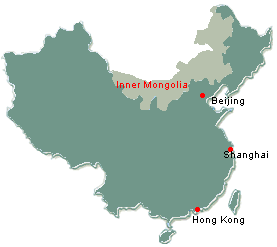|
|
|
Geography of
Inner Mongolia |
Inner
Mongolia (Nei Mongo) Autonomous Region is situated in the
north-most part of China, sharing a common border with the
U.S.S.R. and the People's Republic of Mongolia. The capital
city is
Hohhot. The
Autonomous Region of Inner Mongolia was set up on the 1st of
May, 1947, it is the first autonomous region of minority
nationalities in China. It has an area of over 1.183 million
square kilometers (about 1/8 of total China area) and a
population of 24.71 million (2010), comprising the
Mongolian,
Han,
Daur,
Ewenki,
Oroqen,
Hui,
Manchu,
Korean
and other nationalities. Mongolian shares 18% of total
population in Inner Mongolia.
|
|
|
Inner Mongolia Climate |
|
The Region is bitterly cold in winter and warm in summer. The average
annual temperature is in the range between -1°C
and 10°C
(30.2°F
and 50°F).
In January, the coldest month, the average temperature ranges from -23°C
(-9.4°F)
in the north-eastern part of the Region to -10°C
(14°F)
in the south-western part; in July, the warmest month, the average
temperature ranges from 19°C
(66.2°F)
in the north-eastern part to 24°C
(75.2°F)
in the south-western part. The temperature in the northern part is lower
on the average than in the other places. The frost-free period varies
from 90 to 160 days, and the average annual precipitation is between
50mm and 450mm, mostly in late summer and early autumn. |
|
|
Brief History of
Inner Mongolia |
|
During the period of Warring States, Inner Mongolia was partly occupied
by the State of Zhao and partly inhabited by the Xiongnus—a minority
nationality in the northern part of China. During the Han Dynasty (206
B.C. - 220), it covered the area occupied by the Xiongnus and
prefectures of Wuyuan and Shoufang. In the Tang Dynasty, the autonomous
prefectures of Feng and Seng were set up here. In Yuan Dynasty, it was
divided into the prefectures of Shangdu, Jining, Dening, Jinzhou,
Yinchang, etc. It became Inner Mongolia in Qing Dynasty (1644-1911).
Over the long years in history, Nei Mongol was mainly a place where the
nomadic nationalities lived and moved about. At the turn of the 12th and
13th centuries, under the rule of Genghis Khan, many tribes were unified
into a single nationality with its own language, and the Yuan Empire was
thus founded. After the Yuan Dynasty (1271-1368), Inner Mongolia has
been placed successively under the rule of the Qing Dynasty, the
Northern Warlords, the Kuomintang reactionaries and the Japanese
imperialist. |
|
|
Inner Mongolia
Local Products |
|
|
|
|
Inner Mongolia
Local Cuisine |
|
The Traditional cuisine in Inner Mongolia takes beef and mutton, and
particularly the latter, as its main ingredient. Among the famous
dishes is barbecue lamb, roast tenderloin of lamb, roast leg of lamb,
kebab, boiled mutton or whole lamb. The instant-boiled mutton in hot-pot
to go with Zhaojun rice wine and sesame pancakes is a well-known
delicious course usually served in winter. The beef courses are mostly
braised or roasted. There are braised ox-tail, beef kebab, braised ox
tendon, ox-tendon in egg-white, etc. Camel hoof with other delicacies is
a dish that matches the taste of braised bear's paw and red-cooked or
steamed mushrooms are real delicacies. The world-famous facia (a kind of
edible algae), which means good omen and fortune to the native people,
needs meticulous skill in preparing. It can be either cooked with meat
made into vegetarian dishes, such as facia in egg-white and facia in
casserole that unbelievable delicious. Braised elk's nose and crisp
fried hazel grouse are all renowned delicacies. |
|
|
Places of Interests /Tourist Attractions of
Inner Mongolia |
|
|
|
|
|
|
|
|
|
|
|
Useful Links
about
Inner Mongolia |
|
|
|
|
Related Article and Report Links |
-
China: The
environmental and cultural harm to Inner Mongolia's
grasslands - Temperatures and tensions are rising as
miners - and tourists - move in to one of China's most
remote and ecologically fragile regions (click
for detailson Environmental Blog on Guardian
UK)
-
Fascinating landscapes on Hulun Buir
Grassland (Pictures)
|
|
|
|
|
|
|
|
|


